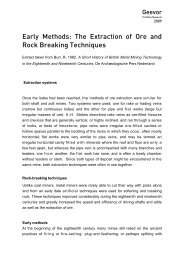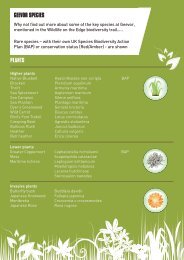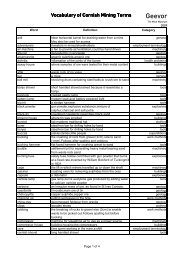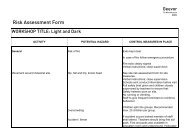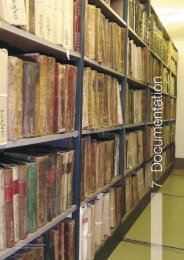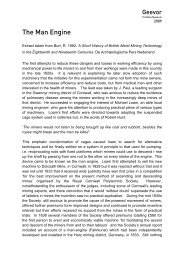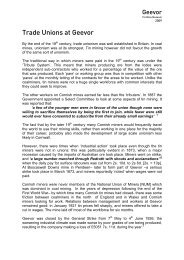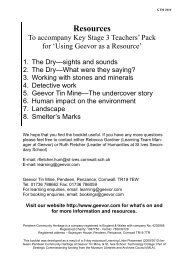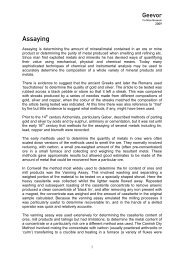Properties of Metals.pdf - Geevor Tin Mine
Properties of Metals.pdf - Geevor Tin Mine
Properties of Metals.pdf - Geevor Tin Mine
You also want an ePaper? Increase the reach of your titles
YUMPU automatically turns print PDFs into web optimized ePapers that Google loves.
<strong>Geevor</strong><br />
<strong>Tin</strong> <strong>Mine</strong> Museum<br />
2009<br />
<strong>Properties</strong> <strong>of</strong> <strong>Metals</strong><br />
Out <strong>of</strong> the ninety naturally occurring elements around seventy are classified as<br />
metals. When we describe something as being metallic it is <strong>of</strong>ten because it is hard,<br />
heavy, lustrous and strong enough to be made into huge variety <strong>of</strong> tools, machines<br />
and structures. This is true for many metals but there are exceptions to these basic<br />
properties.<br />
Humans first used metals about 8000 years ago and by 6500 years ago began to<br />
extract metals from ores.<br />
The most abundant metal on Earth is iron forming around 35% <strong>of</strong> the Earth’s total<br />
mass, most <strong>of</strong> the iron is concentrated at the earth’s centre where it forms a solid<br />
inner and liquid outer core along with some nickel. The crust <strong>of</strong> the Earth contains<br />
about 5% iron. Iron is the metal most widely used by man many millions <strong>of</strong> tonnes<br />
are extracted and smelted each year to make steel etc. Iron is one <strong>of</strong> the metals<br />
essential for life the average human contains enough iron to make a 1inch nail.<br />
Some <strong>of</strong> the rarest metals found on Earth include Francium; the heaviest <strong>of</strong> the alkali<br />
metals, less than an ounce (28gms) is thought to exist in the Earth’s crust.<br />
Gold is a comparatively rare metal that has been sought and prized by man for many<br />
thousands <strong>of</strong> years. Gold is <strong>of</strong>ten found in the un-combined or native state. The<br />
largest single mass <strong>of</strong> gold discovered was the Holtermann nugget – a slab <strong>of</strong> slate<br />
and gold weighing 213.14 kg. It was found in the Beyers and Holterman Star <strong>of</strong> Hope<br />
<strong>Mine</strong>, Hill End, NSW Australia in October 1872, it contained 82.11 kg <strong>of</strong> pure gold.<br />
The largest pure nugget was the Welcome Stranger, containing 69.92 kg <strong>of</strong> pure<br />
gold, it was found at Moliagul, Victoria, Australia in 1869 by John Deason, from the<br />
Isles <strong>of</strong> Scilly, and Richard Oats from west Cornwall.<br />
Gold is a s<strong>of</strong>t heavy metal (specific gravity 19.3), malleable and the most ductile.<br />
One gram <strong>of</strong> gold can be drawn into a wire 2.4 kilometres in length or one ounce to<br />
43 miles. The metal does not tarnish and has always been used for jewellery and<br />
decorative purposes. Much <strong>of</strong> the world’s extracted gold is held in storage vaults as<br />
bullion to support many <strong>of</strong> the worlds financial systems.<br />
Platinum metal like gold is also found in the native state. Platinum is the most<br />
important <strong>of</strong> a group <strong>of</strong> six closely related rare metals the others being osmium,<br />
iridium, palladium, rhodium and ruthenium. Platinum is relatively s<strong>of</strong>t and heavy<br />
(specific gravity 21.45) with a high melting point (1773.5°C) and resistance to attack<br />
by most chemical reagents. It is used to make jewellery, special scientific apparatus<br />
and electrical contacts.<br />
Osmium is the densest metal on earth with a specific gravity <strong>of</strong> 22.48. A 12inch (30<br />
cm) cube <strong>of</strong> osmium would weigh around 1,345 lbs (610 kgs). A similar cube <strong>of</strong><br />
lithium, the lightest metal with a specific gravity <strong>of</strong> 0.585, would weigh only 32 lbs<br />
1
<strong>Geevor</strong><br />
<strong>Tin</strong> <strong>Mine</strong> Museum<br />
2009<br />
(14.4kgs). Osmium when mixed with iridium forms osmiridium a very hard alloy<br />
traditionally used for making pen nibs.<br />
Tungsten is a very hard metal used to make special steels and carbides for cutting<br />
tools, drills, armoured plate and projectiles for military use. It is the metal with the<br />
highest melting point (3370°C) and is widely used to make electric light bulb<br />
filaments and electrodes for TIG (tungsten inert gas) welding systems. Tungsten is<br />
found as the mineral wolframite and was <strong>of</strong>ten recovered along with cassiterite in<br />
many Cornish mines.<br />
The metal with the lowest melting point is mercury or quicksilver. It has a melting<br />
point <strong>of</strong> -38.9°C, thus at normal temperatures it is liquid. Mercury is able to dissolve<br />
many other metals, particularly gold, to form alloys (called amalgams). Other uses<br />
include the manufacture <strong>of</strong> batteries, scientific instruments like thermometers,<br />
lighting and detonators.<br />
Te rare metal gallium has a melting point <strong>of</strong> 30.15°C thus it would melt if held in the<br />
hand.<br />
Mercury vapour and many <strong>of</strong> its compounds are very poisonous but there are<br />
several metals that are deadly to man, some in minute quantities. Lead has been<br />
used for several thousand years to make water pipes, cisterns and as a component<br />
<strong>of</strong> pewter for tableware and drinking vessels. It has been suggested that a<br />
contributing factor to the downfall <strong>of</strong> the Roman Empire was the poor health suffered<br />
by many Roman citizens due to lead poisoning. Other highly toxic metals include<br />
antimony, cadmium, barium and thallium.<br />
The most toxic <strong>of</strong> all metals are those that are radioactive. <strong>Metals</strong> such as uranium,<br />
radium, thorium and polonium occur naturally in many parts <strong>of</strong> the world. When<br />
these metals are extracted and concentrated their handling and disposal can be very<br />
hazardous and problematic. One <strong>of</strong> the most deadly <strong>of</strong> all metals is thorium 228. It<br />
has been calculated that exposure to 2.4 x 10 –16 gms <strong>of</strong> thorium 228 per cubic<br />
metre <strong>of</strong> air would be fatal.<br />
2



